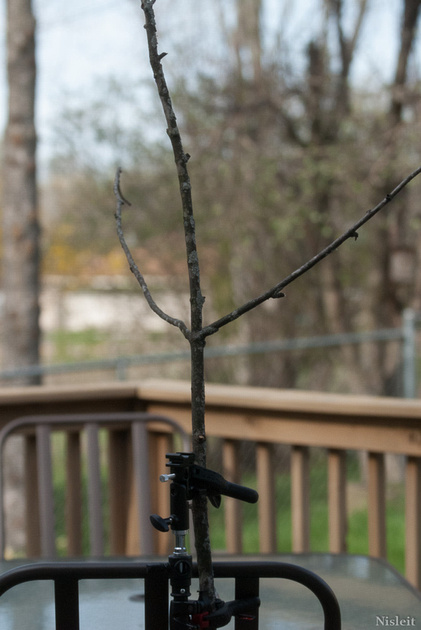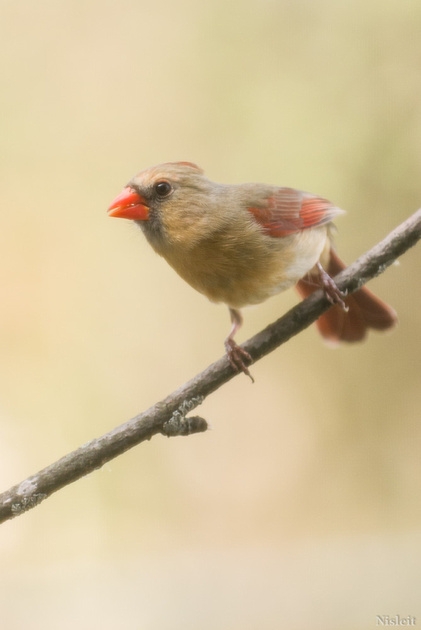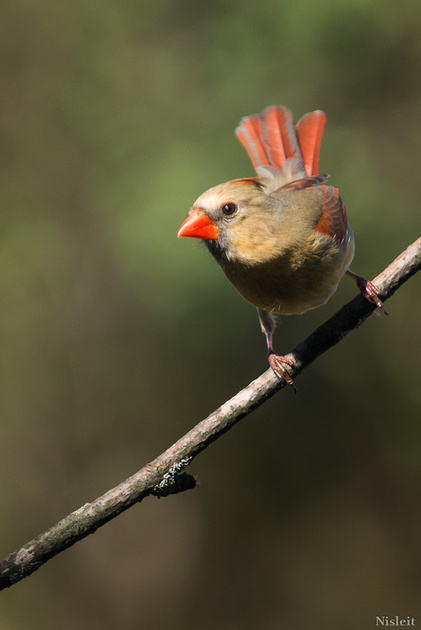Get Better Close-Up Pictures of Birds
This wasn't planned, but recently a female cardinal started building a nest on top of outdoor lights over our deck in the back yard. The cardinal's flight path was directly in front of my office window, so I took the opportunity to use the situation to get some great shots.
To make great shots, you can't just hope for the best. Professional images are the result of control, but how can you control a nesting cardinal? With biology, of course. First I thought about light and background. I used the Nikkor 70-200 mm f/2.8 VR lens on a DX camera, which gave me an effective focal length of 300 mm, so I could get close, isolate the subject and throw the background out of focus. There were few angles that afforded me a great background, but one was toward a tree in the neighbor's yard, which worked well.
Second, I needed a stage. I noticed the bird frequently landed on the back of a patio chair. I thought instead I could introduce to her a nice comfortable branch, something familiar to her, conveniently fixed to a light stand. I immediately went to the shed to look through the twigs I'd stored up for fire use and found a nice sturdy one and trimmed the smaller twigs off to create a better platform for the bird and picture. I placed the branch where I knew there'd be light and where I knew it would line up with my background. Stage set.


This is it -- a branch rigged to a light stand outside my office window. Anything you can do to make an animal's life easier makes it more likely to come close to you. Providing a nice comfortable branch, just right for the bird's feet, is one way to get a bird to pose where you want it to. But you should place it where you know the bird will likely use it, such as near a nest or feeder. Placing the branch gives you control over the background and setting.
Next I just had to wait for the bird to use the branch. Having it near the nest (off-camera to left) and in her flight path made it a very good prospect. After several flights to and from the nest, bringing material and constructing, the bird finally landed on the branch, possibly to see what was going on behind my window. Excitement! I clicked away in aperture priority, ISO 400 because of the lower light, and some minus exposure comp. I used single focus rather than continuous, which tends to search too much. I kept the aperture at f/4 to ensure I got as much of the bird in focus as I could and still blur the background.


Nice, but I wanted better. First, there are two different light sources. The subject is in the shade, but the background is in the sun. Exposing for the subject caused the background to go much brighter than I wanted. Second, I still had the screen on the window. My wife helped me pop out the screen so I could open the window and get a shot without glass.
So, the next day I was ready to get even better pictures when the cardinal returned. I waited for the same light to be on the subject and background so I could get a more balanced, rich exposure, and when the bird landed, I photographed away!


Much better -- no glass or screen in the way, and better light! I lowered ISO to 200, still on aperture priority, getting about 1/1600 shutter speed. I could get about f/5.6 before the background started becoming a distraction. You don't always need 2.8; f/4 looks about the same when the subject is that close and the background is that far away. The camera is about 8 feet from the subject. This shows you that 300 mm is the minimum you need for good bird shots even at close range. For small birds 400 mm would be ideal at this range, but for anything else, 600 mm or more is required.
Thanks to Moose Peterson for his tips on using biology to get close to wildlife. I've long admired Moose's work and even attended one of his seminars a few years ago and got to ask him some questions and have him sign an "Outdoor Photographer" issue. I applied Moose's tips to my own situation to get these great cardinal shots and look forward to using them some more. It just goes to show you don't need to invest in gear to get better pictures. These images, and most of the images on my site, were taken with a Nikon D200. Can you tell the difference between them and images from a D3s or D4, D600 or D7100? Invest in learning and work, and better images will come.

